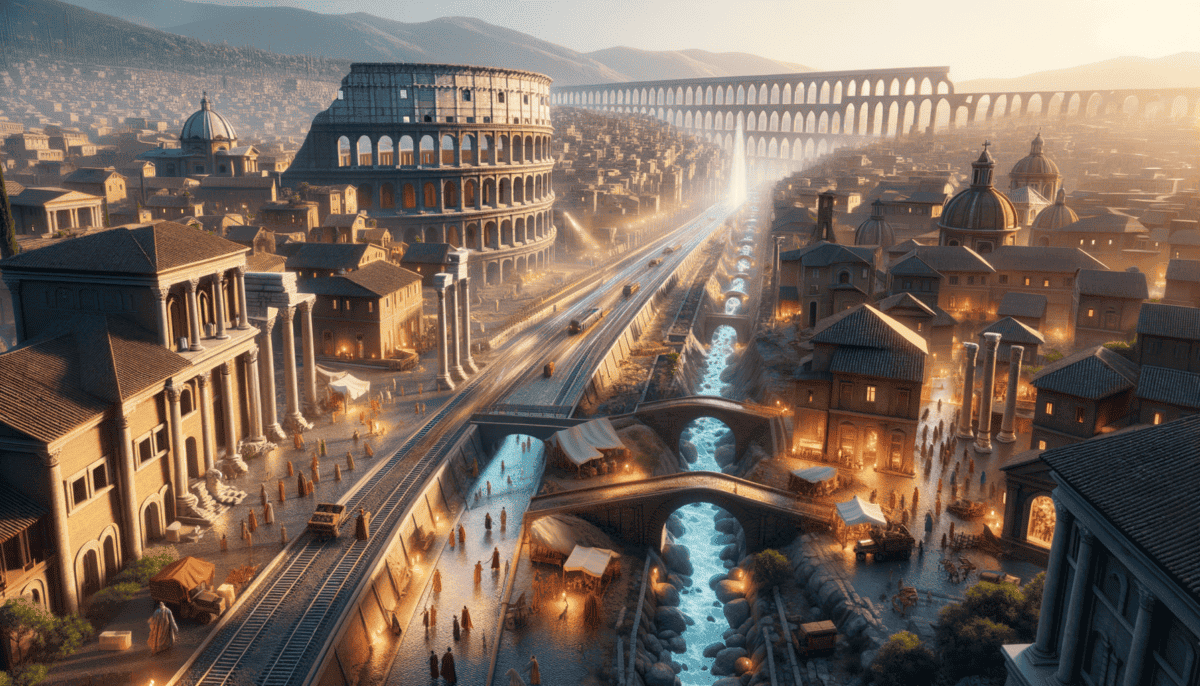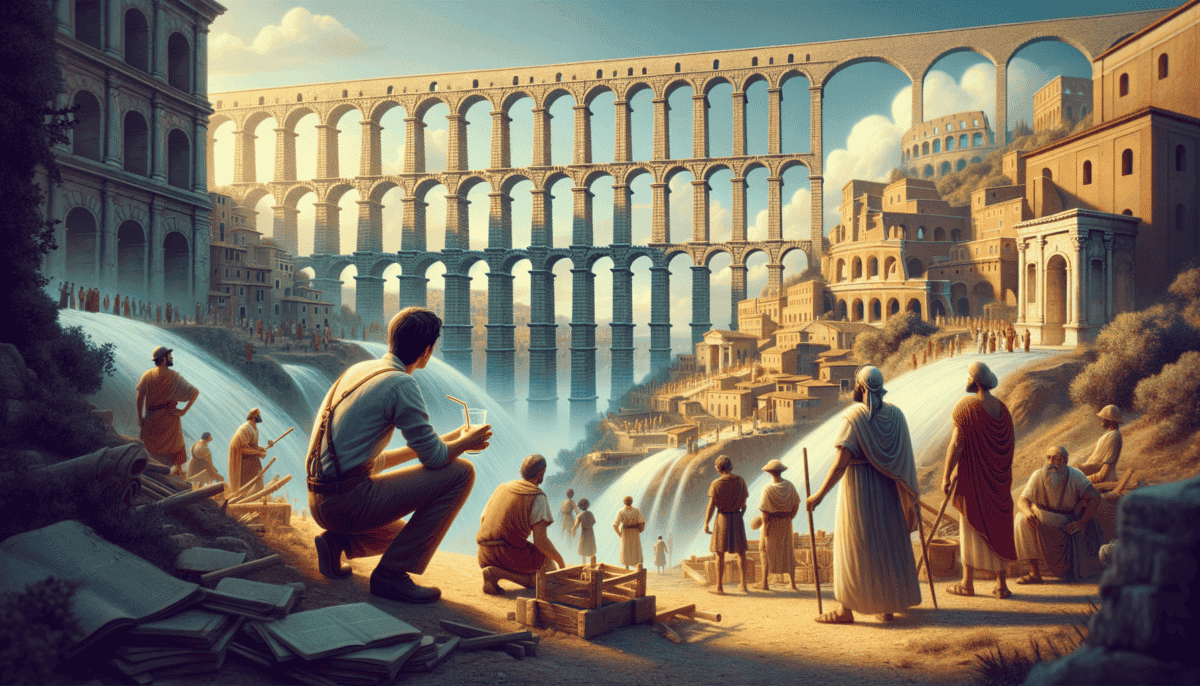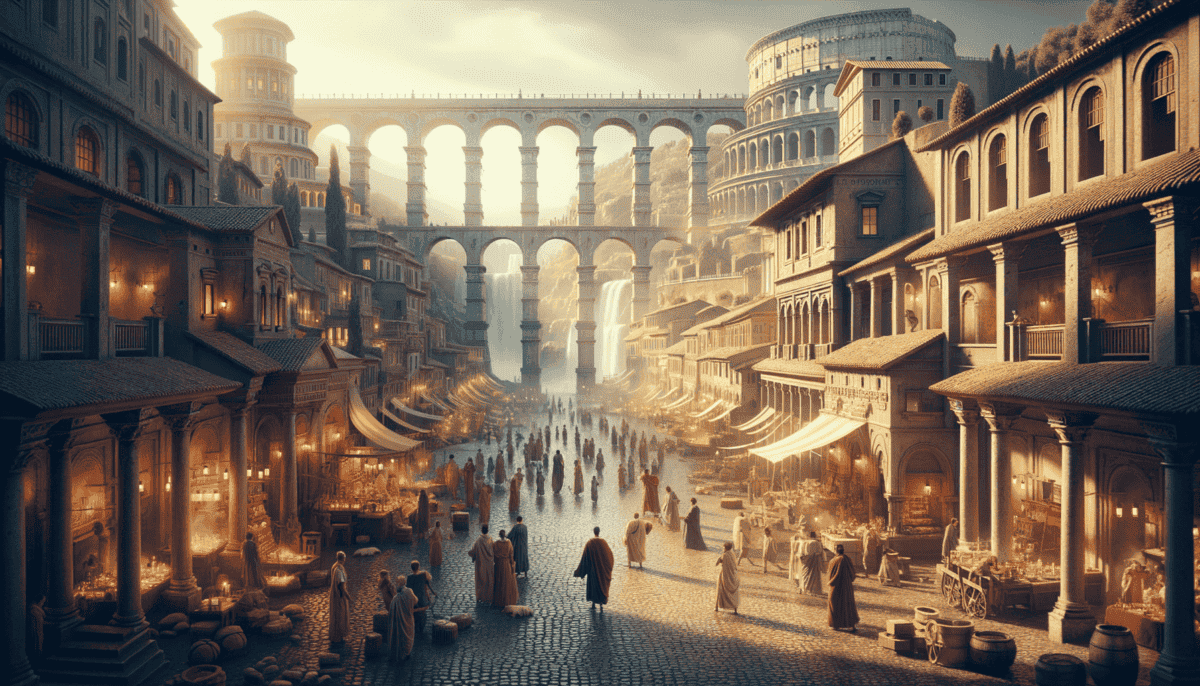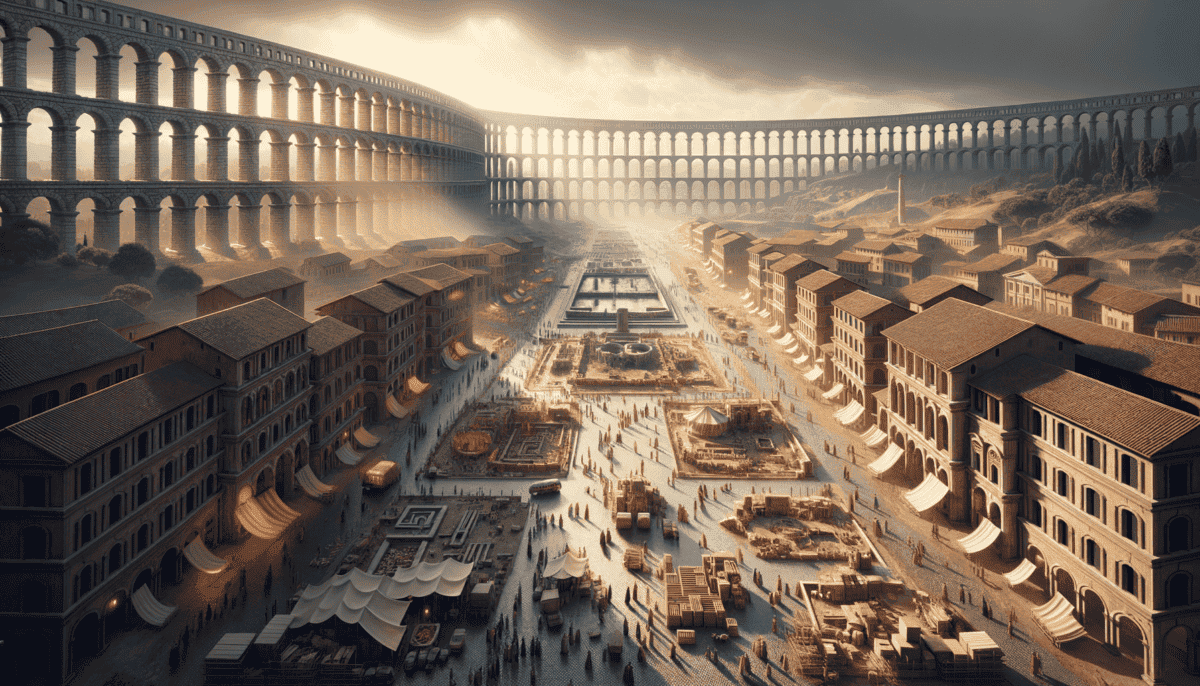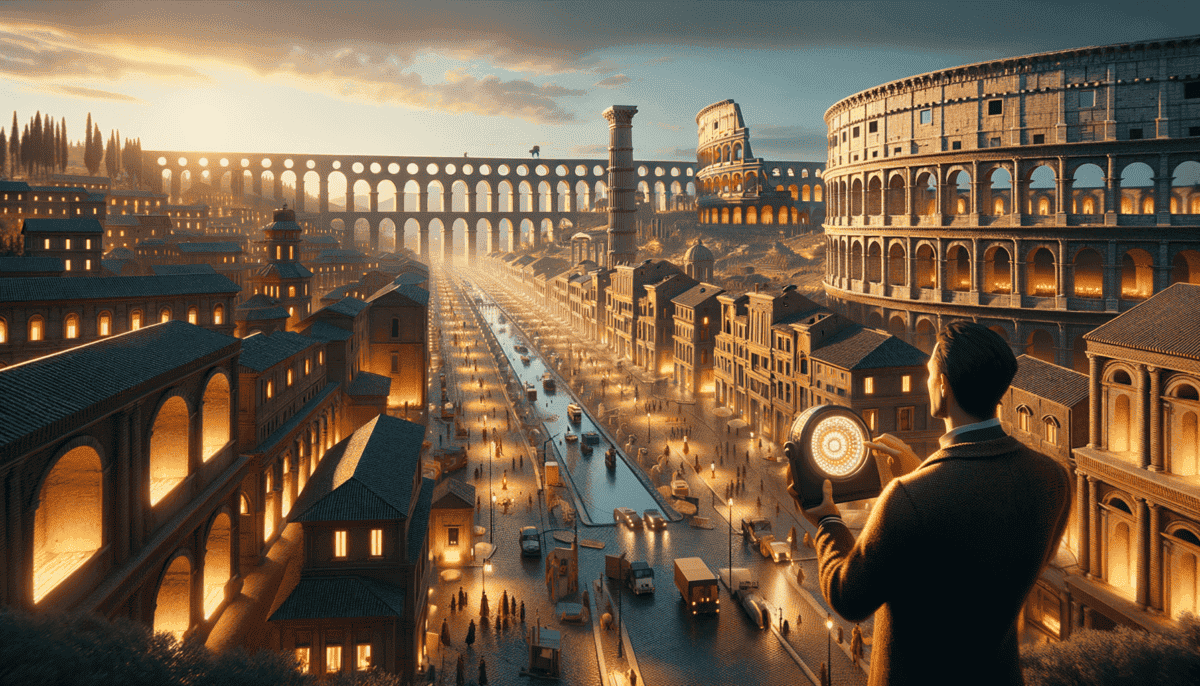The Grid of Discovery
Marco tapped his pencil against his textbook, trying to stay awake during his urban planning lecture. The clock seemed frozen at 2:45 PM. His eyes felt heavy. Just five more minutes…
Suddenly, the classroom started spinning!
"Whoa!" Marco grabbed his desk, but everything went dark. When he opened his eyes, he wasn't in his classroom anymore. The air smelled different – like smoke and dust. People walked past wearing strange clothes that looked like bed sheets.
"Where am I?" Marco whispered. He looked down at his jeans and t-shirt. They definitely didn't match what everyone else was wearing.
Marco had traveled back in time to the early Roman Republic – around 500 BCE!
"You there, boy!" called a stern voice. "Why are you dressed so strangely?"
Marco turned to see a tall man in a white toga. He had a scroll tucked under his arm and was studying Marco with curious eyes.
"I… um… I'm not from around here," Marco stammered.
The man smiled. "I can see that! I am Claudius, the city architect. You've arrived at an exciting time – we're planning a whole new section of Rome!"
Marco's eyes lit up. This was way better than reading about ancient Rome in a textbook!
"Can I help?" Marco asked eagerly.
Claudius nodded. "Follow me. I'll show you how we're building the greatest city in the world!"
They walked to a large open area where workers were measuring the ground with ropes and wooden stakes.
"First, we create a perfect grid," Claudius explained. He drew lines in the dirt. "Every Roman city starts with two main streets that cross in the middle – the cardo and the decumanus."
“The grid system helps people find their way around easily. It’s like the squares on a checkerboard!” – Claudius
Marco watched in amazement as the workers marked out straight streets and equal-sized blocks. Some areas were marked for houses, others for shops and temples.
"But why build everything in squares?" Marco asked.
Claudius smiled. "Order creates harmony. When a city is well-planned, people live better lives. The streets are clean, water flows where it should, and everyone can find their way home."
As the sun began to set, Marco could see the future city taking shape. The wooden stakes showed where buildings would stand, where people would walk, and where children would play.
"This is incredible!" Marco exclaimed. "In my ti— I mean, where I'm from, we still use many of these same ideas!"
"A good plan is timeless," Claudius said wisely. "Remember that, young friend."
The sky grew darker, and Marco felt dizzy again. The world started spinning…
When everything stopped, Marco was back in his classroom. The clock now read 2:50 PM.
Had it all been a dream? But his shoes were still dusty from the construction site, and he could smell ancient Rome on his clothes. Marco smiled, knowing he had discovered something amazing about how cities began.
His professor's voice brought him back to the present: "And now, let's discuss the influence of Roman city planning…"
For the first time ever, Marco couldn't wait to learn more. After all, he had just seen it with his own eyes! ️
Roads that Connect an Empire
Marco’s head was still spinning from his first time-travel adventure when it happened again! This time, he found himself standing on a dusty path outside Rome. The morning sun was rising, and sounds of construction filled the air.
“Watch out!” someone shouted. Marco jumped aside as a team of workers rolled past with huge stone blocks.
A friendly-looking man with a measuring stick waved him over. “You must be the new helper! I’m Flavius, the road engineer.”
Romans built over 250,000 miles of roads – enough to circle Earth 10 times!
“Today we’re building a new road to connect Rome with the coastal cities,” Flavius explained. “Want to see how we do it?”
Marco nodded eagerly. He watched as workers dug a deep trench in the ground.
“First, we dig down deep,” Flavius said. “A good road needs a strong base, just like a house needs a good foundation.”
The workers filled the trench with different layers:
- Big rocks on the bottom
- Smaller stones in the middle
- Gravel and sand on top
- Flat stones for the surface
“Why so many layers?” Marco asked.
Flavius smiled. “Rain needs somewhere to go! The water drains through the layers instead of making puddles. Smart, right?”
“All roads lead to Rome because we build them that way!” – Flavius
They walked along the construction site. Workers used special tools to make sure the road was straight and slightly raised in the middle.
“The curved top helps rain water run off,” Flavius explained. “And look – we put stones along the sides to mark every mile.”
Marco saw soldiers marching past on a finished section of road. Behind them came merchants with carts full of goods.
“Our roads help move armies quickly,” Flavius said proudly. “But they also bring food, news, and traders from far away. Roads connect people!”
The day grew hot as they worked. Marco helped place stones and learned to use Roman measuring tools. His back ached, but he felt proud seeing the road take shape.
“It’s amazing,” Marco said. “These roads will last for thousands of years!”
Flavius looked surprised. “Thousands? Well, we do build them to last! Speaking of lasting – here comes the most important part.”
Workers brought out huge stone blocks for the road surface. They fit them together perfectly, like a giant puzzle.
“No gaps!” Flavius tapped the stones with his stick. “That’s the secret. When stones fit tight, nothing can break them apart.”
As sunset approached, Marco looked down the new road. It stretched straight as an arrow toward the horizon. He could almost see into the future – countless people would travel this path.
The familiar dizziness returned. The world began to blur…
Back in his classroom, Marco grinned. His sneakers were covered in Roman road dust – proof of another amazing journey! Now he understood why people said Roman roads were built to last forever. ️
Water: The Lifeblood of the City
Whoosh! Marco blinked in the bright sunlight. He stood at the foot of a giant stone structure that reached up into the sky. Water flowed through channels above his head.
“You there! Come help us!” A woman in a simple tunic waved to him. “I’m Julia, the lead water engineer.”
Roman aqueducts brought over 300 million gallons of water to Rome every day! That’s like 450 swimming pools! ♂️
“We’re building something special,” Julia smiled. “It’s called an aqueduct. It brings clean water from the mountains to everyone in Rome.”
Marco watched in amazement as workers carefully placed stone blocks. The structure looked like a giant bridge, but instead of carrying people, it carried water!
“Want to see how it works?” Julia led Marco up some wooden stairs. At the top, they could see water flowing through a clay pipe.
“The secret is gravity,” Julia explained. “Water always flows downhill. We build the channel with a tiny slope – just enough to keep the water moving.”
“Clean water makes a healthy city. That’s why we work so hard to bring it here!” – Julia
They walked along the aqueduct’s maintenance path. Marco saw clever tricks the Romans used:
- Lead pipes to carry water
- Settling tanks to clean the water
- Air holes to release pressure
- Underground tunnels for winter
“Look down there!” Julia pointed to the city below. “See all those fountains? Everyone can get fresh water, rich or poor.”
Marco saw people filling water jugs at public fountains. Children splashed in the cool water. Even animals had special drinking troughs!
“But what about houses?” Marco asked.
“Rich people pay for water pipes to their homes,” Julia explained. “They have fountains and even indoor toilets! But everyone gets water from the public fountains for free.”
Romans used special metal tokens to get extra water from public fountains! Like ancient water tickets! ️
Suddenly, alarms rang out! A crack had formed in one of the water channels.
“Quick!” Julia called. “Help us fix it before we lose water to the whole city!”
Marco joined the repair team. They used special waterproof cement to seal the crack. It was exciting to help keep Rome’s water flowing!
“Water is life,” Julia said as they finished. “Without our aqueducts, Rome couldn’t be such a big city. We need clean water for drinking, cooking, cleaning, and our famous public baths!”
Marco helped test the repair by floating a leaf in the channel. It sailed smoothly past the fixed section.
“Perfect!” Julia clapped. “Now thousands of people will have fresh water today.”
The sun was setting when Marco felt the familiar spinning sensation. The last thing he saw was Julia waving goodbye as water flowed endlessly toward Rome…
Back in his time, Marco turned on his water faucet and smiled. He understood now why the Romans were so proud of their water system. Some Roman aqueducts still worked after 2000 years!
The Forum – Heart of Roman Life
The world stopped spinning, and Marco found himself standing in a massive open square filled with bustling crowds. People in colorful togas rushed past him. The air smelled like fresh bread and spices. ️
The Roman Forum was like a giant outdoor mall, city hall, and community center all in one place!
“Welcome to the Forum, young man!” A friendly voice called out. An older man in a pristine white toga approached. “I am Flavius, one of the city’s senators.”
“This place is huge!” Marco gasped, looking at the grand buildings surrounding the square.
“The Forum is the heart of Rome,” Flavius smiled. “Come, let me show you around!” ♂️
They walked past shops with colorful awnings. Merchants called out to sell their goods:
“Fresh bread from the bakery!”
“Fine silks from the East!”
“Sweet honey cakes – still warm!”
“Look there!” Flavius pointed to a large building with tall columns. “That’s where the Senate meets to make laws. And over there is the court where judges solve problems.”
Marco watched as people gathered around a man speaking from raised steps. “What’s happening there?” he asked.
“That’s a public speech! Anyone can share ideas here. The Forum is where we practice democracy,” Flavius explained proudly.
- Senate House for making laws
- Courts for solving problems
- Temples for worship
- Shops for buying things
- Speaking platforms for sharing ideas
A group of children ran past, playing with wooden toys. Women chatted by a fountain. Old men played board games in the shade.
“The Forum is for everyone,” Flavius said. “Rich or poor, young or old – we all come here to work, play, and be together.”
They stopped at a food stand where a cook was making flat bread. The smell made Marco’s mouth water.
“Here, try some!” The cook handed Marco a piece topped with olive oil and herbs.
“This is delicious!” Marco said between bites.
Suddenly, bells rang out. People started moving toward a big temple.
“It’s time for the midday ceremony,” Flavius explained. “We thank the gods for protecting Rome.”
Marco watched as white doves were released into the sky. People threw flower petals and sang together. It was beautiful! ️
“The Forum isn’t just buildings,” Flavius said softly. “It’s the spirit of Rome. Here, we are all one community.”
As the sun moved across the sky, Marco saw how the Forum changed. In the morning, it was busy with shopping. At noon, people came for ceremonies. In the afternoon, children played while adults talked politics.
“Each stone has a story,” Flavius said, touching a marble column. “Each corner holds memories. This is where Rome’s heart beats strongest.”
The familiar spinning feeling returned just as sunset painted the Forum’s columns golden. Marco’s last view was of families heading home together, their voices echoing off the ancient stones that had watched over Rome’s people for centuries. ✨
Architectural Marvels and Urban Innovation
The spinning stopped, and Marco found himself standing next to a massive construction site. Workers were lifting huge stone blocks using wooden cranes. The sound of hammering and chisels filled the air. ️
“Watch your step, young friend!” A woman in work clothes called out. “I’m Julia, the lead architect here. We’re building something special!”
Marco looked up at the rising walls. “What is it going to be?”
“A public bathhouse!” Julia smiled. “Come see how we make Roman buildings so strong!” ️
Julia showed Marco their building materials:
“See this concrete? It’s stronger than stone!”
“These arches can hold huge weight!”
“Our domed roofs let in light from above!”
Workers poured concrete into wooden forms. Others carefully placed bricks in curved shapes.
“The arch is our secret,” Julia explained, drawing in the dirt. “It makes buildings super strong. Like a rainbow made of stone!”
They walked to another site where a theater was being built. The seats curved up a hillside like giant steps.
“We shape the seats just right,” Julia said. “Everyone can hear the actors, even in the back row!”
- Special concrete that lasts forever
- Curved arches that stay strong
- Round domes that let in light
- Perfect shapes for good sound
- Smart heating systems
Back at the bathhouse, workers were installing floor tiles. “Watch this!” Julia said, lifting a tile. Warm air moved through spaces under the floor. ️
“We heat the floors and walls,” she explained. “The whole building stays cozy!”
Marco touched the warm tiles. “That’s so clever!”
They climbed to the top of a finished building. The view of Rome was amazing! ️
“See how our buildings work together?” Julia pointed. “Temples reach to the sky. Markets welcome everyone. Houses stay cool in summer.”
A group of apprentice builders ran up with exciting news.
“The dome is ready!” they shouted.
Marco watched as workers removed the wooden supports from under a huge concrete dome. It stayed up all by itself! Everyone cheered.
“How does it not fall?” Marco asked in wonder.
“Math and magic,” Julia winked. “We study shapes, weights, and materials. Then we dream big!”
They visited more building sites. Each one showed clever Roman ideas:
– Tall columns that looked like trees
– Windows that caught the best light
– Decorated walls that told stories
“Our buildings do more than just stand up,” Julia said. “They make life better. They bring people together.”
The sun was setting when they reached a temple with rainbow-colored marble columns.
“Beautiful, isn’t it?” Julia smiled. “Remember, Marco – great buildings come from great dreams. We Romans dream very big!”
As the familiar spinning started again, Marco saw workers carving their names into stones they had placed. Their proud smiles would last as long as their amazing buildings. ⭐
Timeless Lessons from Ancient Rome
The world spun one last time. Marco found himself back in modern Rome, standing in front of the Pantheon. Its massive dome still reached toward the sky, just as beautiful as when he had watched it being built. ️
“I can’t believe I’m back,” Marco whispered, touching the old stones. They felt warm, like they remembered every hand that had touched them over thousands of years.
A tour group walked by. Marco smiled as he heard their guide say, “This building is almost 2,000 years old!”
He thought about everything he had seen:
The clever grid streets that made cities easy to walk through
The strong roads that connected far places
The amazing aqueducts that brought clean water
The busy forum where people met and talked
The smart buildings that made life better
Marco pulled out his notebook and wrote down what Ancient Rome taught him: ️
- Plan streets carefully
- Build things to last
- Make places where people can meet
- Use clever ideas to solve problems
- Think about what people need
Looking around modern Rome, Marco saw the old and new city working together. Cars drove on streets first built for chariots. People still met in squares like the ancient forum.
He walked to a coffee shop and sat down to write a letter to his new Roman friends:
Dear Claudius, Julia, Marcus, and all my Roman friends,
Thank you for showing me how to build a great city. Your ideas were so smart that we still use them today! When I become an urban planner, I'll remember what you taught me.
Your friend from the future,
Marco
A group of kids ran by, playing soccer in a piazza. Their happy shouts echoed off buildings old and new. Marco smiled, knowing that good city planning helps people live happy lives.
“The Romans knew what made a city great,” Marco said to himself. “And those ideas still work today!”
He opened his textbook to take notes and found something surprising – a small piece of Roman concrete had somehow traveled through time with him!
Marco carefully placed it on his desk at home. It would remind him that great ideas last forever, just like Roman buildings.
Looking out his window at the city, Marco knew his adventure had taught him the most important lesson: cities should be built with love and care for all the people who will live in them.
That night, Marco dreamed of building his own city someday. It would have the best ideas from ancient Rome and new smart ideas too. After all, good planning never goes out of style! ⭐
As the sun set over Rome’s ancient domes and modern buildings, Marco knew his journey through time had changed him forever. He was ready to help build the cities of tomorrow, using the wisdom of yesterday.


